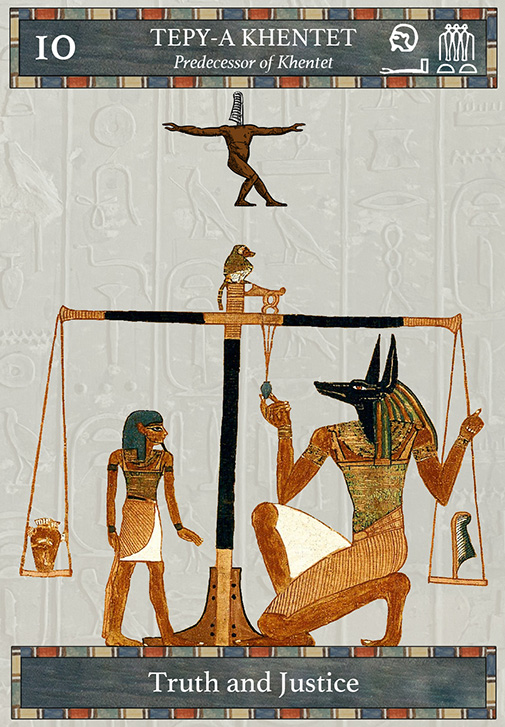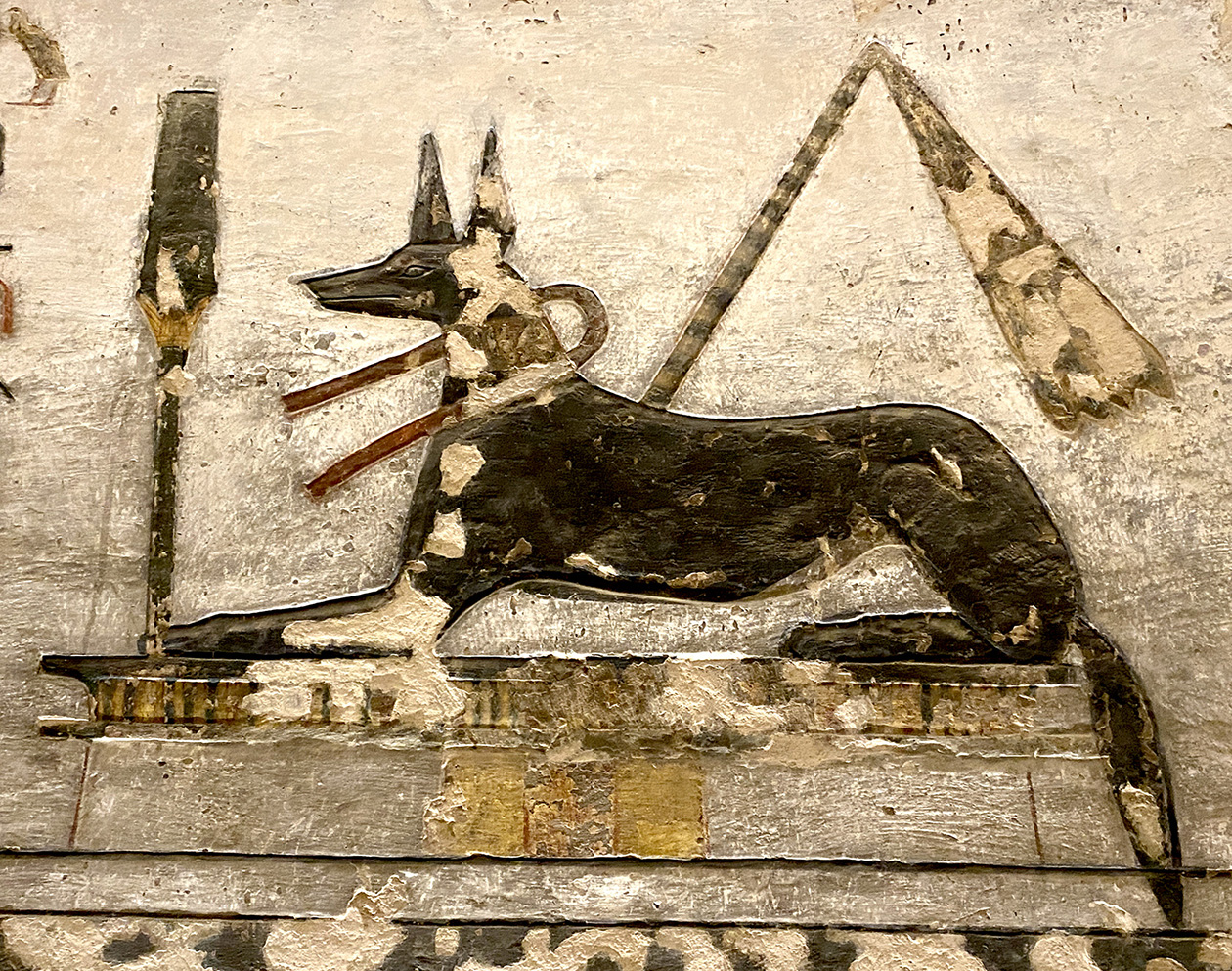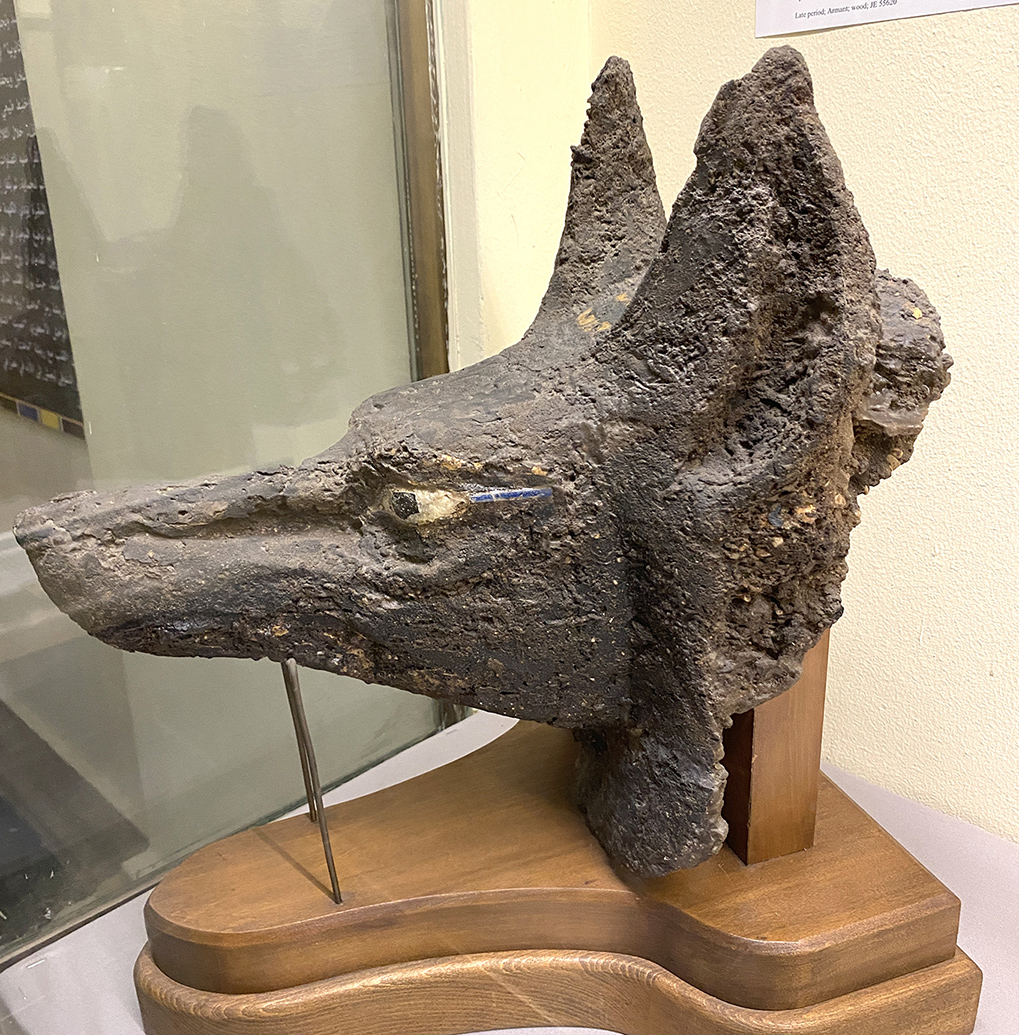Anubis
Anubis also known as Inpu, Inpw, Jnpw, or Anpu is the god of funerary rites, protector of graves, and guide to the underworld, in ancient Egyptian religion, usually depicted as a canine or a man with a canine head.
Like many ancient Egyptian deities, Anubis assumed different roles in various contexts. Depicted as a protector of graves as early as the First Dynasty (c. 3100 – c. 2890 BC), Anubis was also an embalmer. By the Middle Kingdom (c. 2055–1650 BC) he was replaced by Osiris in his role as lord of the underworld. One of his prominent roles was as a god who ushered souls into the afterlife. He attended the weighing scale during the "Weighing of the Heart," in which it was determined whether a soul would be allowed to enter the realm of the dead.
Anubis is one of the most frequently depicted and mentioned gods in the Egyptian pantheon, however, no relevant myth involved him.
Name
"Anubis" is a Greek rendering of this god's Egyptian name. Before the Greeks arrived in Egypt, around the 7th century BC, the god was known as Anpu or Inpu. The root of the name in ancient Egyptian language means "a royal child." Inpu has a root to "inp," which means "to decay."
The god was also known as "First of the Westerners," "Lord of the Sacred Land," "He Who is Upon his Sacred Mountain," "Ruler of the Nine Bows," "The Dog who Swallows Millions," "Master of Secrets," "He Who is in the Place of Embalming," and "Foremost of the Divine Booth." The positions that he had were also reflected in the titles he held such as "He Who Is upon His Mountain," "Lord of the Sacred Land," "Foremost of the Westerners," and "He Who Is in the Place of Embalming."
Background
In Egypt's Early Dynastic period (c. 3100 – c. 2686 BC), Anubis was portrayed in full animal form, with a "jackal" head and body. A jackal god, probably Anubis, is depicted in stone inscriptions from the reigns of Hor-Aha, Djer, and other pharaohs of the First Dynasty. Since Predynastic Egypt, when the dead were buried in shallow graves, jackals had been strongly associated with cemeteries because they were scavengers which uncovered human bodies and ate their flesh. In the spirit of "fighting like with like," a jackal was chosen to protect the dead, because "a common problem (and cause of concern) must have been the digging up of bodies, shortly after burial, by jackals and other wild dogs which lived on the margins of the cultivation."
In the Old Kingdom, Anubis was the most important god of the dead. He was replaced in that role by Osiris during the Middle Kingdom (2000–1700 BC). In the Roman era, which started in 30 BC, tomb paintings depict him holding the hand of deceased persons to guide them to Osiris.
The parentage of Anubis varied between myths, times and sources. In early mythology, he was portrayed as a son of Ra. In the Coffin Texts, which were written in the First Intermediate Period (c. 2181–2055 BC), Anubis is the son of either the cow goddess Hesat or the cat-headed Bastet. Another tradition depicted him as the son of Ra and Nephthys. Plutarch (c. 40–120 AD) reported a tradition that Anubis was the illegitimate son of Nephthys and Osiris, but that he was adopted by Osiris's wife Isis.
In the Ptolemaic period (350–30 BC), when Egypt became a Hellenistic kingdom ruled by Greek pharaohs, Anubis was merged with the Greek god Hermes, becoming Hermanubis. The two gods were considered similar because they both guided souls to the afterlife. The center of this cult was in Cynopolis, a place whose Greek name means "city of dogs." In Book XI of The Golden Ass by Apuleius, there is evidence that the worship of this god was continued in Rome through at least the 2nd century. Indeed, Hermanubis also appears in the alchemical and hermetical literature of the Middle Ages and the Renaissance.
Although the Greeks and Romans typically scorned Egyptian animal-headed gods as bizarre and primitive (Anubis was mockingly called "Barker" by the Greeks), Anubis was sometimes associated with Sirius in the heavens and Cerberus and Hades in the underworld. In his dialogues, Plato often has Socrates utter oaths "by the dog" (Greek: kai me ton kuna), "by the dog of Egypt," and "by the dog, the god of the Egyptians," both for emphasis and to appeal to Anubis as an arbiter of truth in the underworld.
Priests
Priests of Anubis were heavily involved in Egypt's embalming workshops. A male priest would have been present during the embalming process to read the spiritual rites while the physical embalming was occurring. Some of these priests (although not all) wore a wooden mask made in the likeness of Anubis when performing these rituals. The mask was worn on top of the head like a hat so the priest's face could be seen from underneath as he read the ritual from a scroll.
Because anyone involved in the embalming process was connected spiritually to Anubis, there were many different designations for those who served him.
- Hqa-nTr-inpw - High Priest of Anubis
- wt inpw - Priest of Anubis
- rmt-inpw - Priest Wearing Anubis Mask
- xrpt - Priestess of Anubis
- imy-r-wtw - Overseer of the Bandages
- sHD-wtw - Inspector of the Bandages
- wt(w) - Bandager
Roles

Embalmer
As jmy-wt "He who is in the place of embalming," Anubis was associated with mummification. He was also called ḫnty zḥ-nṯr "He who presides over the god's booth," in which "booth" could refer either to the place where embalming was carried out or the pharaoh's burial chamber.
In the Osiris myth, Anubis helped Isis to embalm Osiris. Indeed, when the Osiris myth emerged, it was said that after Osiris had been killed by Set, Osiris's organs were given to Anubis as a gift. With this connection, Anubis became the patron god of embalmers; during the rites of mummification, illustrations from the Book of the Dead often show a wolf-mask-wearing priest supporting the upright mummy.
Protector of tombs
Anubis was a protector of graves and cemeteries. Several epithets attached to his name in Egyptian texts and inscriptions referred to that role. Khenty-Amentiu, which means "foremost of the westerners" and was also the name of a different canine funerary god, alluded to his protecting function because the dead were usually buried on the west bank of the Nile.
The Jumilhac papyrus recounts another tale where Anubis protected the body of Osiris from Set. Set attempted to attack the body of Osiris by transforming himself into a leopard. Anubis stopped and subdued Set, however, and he branded Set's skin with a hot iron rod. Anubis then flayed Set and wore his skin as a warning against evil-doers who would desecrate the tombs of the dead. Priests who attended to the dead wore leopard skin in order to commemorate Anubis' victory over Set. The legend of Anubis branding the hide of Set in leopard form was used to explain how the leopard got its spots.
Guide of souls
By the late pharaonic era (664–332 BC), Anubis was often depicted as guiding individuals across the threshold from the world of the living to the afterlife. Though a similar role was sometimes performed by the cow-headed Hathor, Anubis was more commonly chosen to fulfill that function.
Greek writers from the Roman period of Egyptian history designated that role as that of "psychopomp," a Greek term meaning "guide of souls" that they used to refer to their own god Hermes, who also played that role in Greek religion. Plutarch believed Anubis filled a similar role as Hecate, saying, "Anubis seems to be of much the same power and nature as the Grecian Hecate, a deity common both to the celestial and infernal regions."
Funerary art from that period represents Anubis guiding either men or women dressed in Greek clothes into the presence of Osiris, who by then had long replaced Anubis as ruler of the underworld.
Weigher of hearts
One of the roles of Anubis was as the "Guardian of the Scales." The critical scene depicting the weighing of the heart, in the Book of the Dead, shows Anubis performing a measurement that determined whether the person was worthy of entering the realm of the dead (the underworld, known as Duat). By weighing the heart of a deceased person against the feather of Ma'at (or "truth"), who was often represented as an ostrich feather, Anubis dictated the fate of souls. Souls heavier or lighter than a feather would be devoured by Ammit, while souls exactly the same weight as the feather would ascend to a heavenly existence.
Portrayal in art
Anubis was one of the most frequently represented deities in ancient Egyptian art. He is depicted in royal tombs as early as the First Dynasty. The god is typically treating a king's corpse, providing sovereign oversight to mummification rituals and funerals, or standing with fellow gods at the Weighing of the Heart of the Soul in the Hall of Two Truths.
One of the most common representations is Anubis with the body of a man and the head of a jackal with pointed ears, standing or kneeling, holding a gold scale while a heart of the soul is being weighed against Ma'at's white truth feather.

